NCERT Solutions Class 11 Biology Chapter 22 - Chemical Coordination and Integration
Q1: Define the following:
(a) Exocrine gland
(b) Endocrine gland
(c) Hormone
Ans: (a) Exocrine glands: Glands that discharge secretions into ducts are known as exocrine glands. Sebaceous gland in the skin, salivary gland in the buccal cavity, etc. are examples of exocrine glands.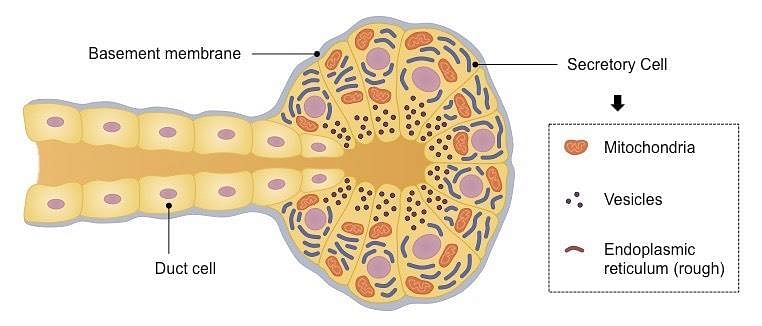
(b) Endocrine glands: Glands that do not discharge their secretions into ducts are known as endocrine glands. Instead, these glands discharge their secretions directly into the blood. Pituitary gland, thyroid gland, adrenal gland, etc. are examples of endocrine glands.
(c) Hormones: Hormones are chemical messengers that regulate physiological processes in living organisms. They act upon specific cells/tissues/organs which are called target cells/tissues/organs.
Q2: Diagrammatically indicate the location of the various endocrine glands in our body.
Ans: The location of various endocrine glands in the human body can be illustrated as follows
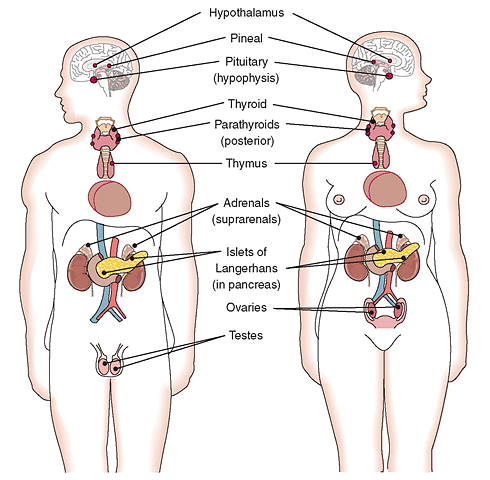
Q3: List the hormones secreted by the following:
(a) Hypothalamus
(b) Pituitary
(c) Thyroid
(d) Parathyroid
(e) Adrenal
(f) Pancreas
(g) Testis
(h) Ovary
(i) Thymus
(j) Atrium
(k) Kidney
(l) G-I Tract
Ans: (a) Hypothalamus: Hormones secreted by the hypothalamus include:
(1) Releasing hormones: These hormones stimulate the secretions of the pituitary hormone. Examples of these hormones are:
(i) Gonadotrophin-releasing hormone
(ii) Thyrotrophin-releasing hormone
(iii) Somatotropin-releasing hormone
(iv) Adrenocorticotrophin-releasing hormone
(2) Inhibiting hormones: These hormones inhibit the secretions of the pituitary hormone. Examples of these hormones are:
(i) Somatostatin
(ii) Growth-inhibiting hormone
(iii) Melanocyte-inhibiting hormone
(b) Pituitary: The pituitary gland has two components i.e., adenohypophysis and neurohypophysis.
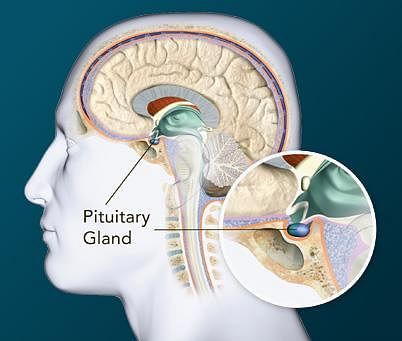 Hormones secreted by the adenohypophysis are:
Hormones secreted by the adenohypophysis are:
(i) Growth hormone (GH)
(ii) Prolactin
(iii) Thyroid-stimulating hormone (TSH)
(iv) Adrenocorticotrophic hormone (ACTH)
(v) Luteinizing hormone (LH)
(vi) Follicle-stimulating hormone (FSH)
(vii) Melanocyte-stimulating hormone (MSH)
Hormones secreted by the neurohypophysis are:
(i) Oxytocin
(ii) Vasopressin
(c) Thyroid: The thyroid gland secretes three hormones namely, thyroxin, triiodothyronin, and calcitonin.
(d) Parathyroid: The parathyroid gland secretes a hormone known as the parathyroid hormone.
(e) Adrenal: The adrenal gland is divided into two parts, the outer adrenal cortex and the inner adrenal medulla.
Hormones of adrenal cortex include the following:
(i) Mineralocorticoids: The hormone secreted is known as aldosterone.
(ii) Glucocorticoids: The hormone secreted is cortisol.
Hormones of adrenal medulla are adrenaline and nor-adrenalin.
(f) Pancreas: Hormones secreted by the pancreas are insulin and glucagon.
(g) Testis: The hormone secreted by the testis is testosterone.
(h) Ovary: The hormone secreted by the ovary includes estrogen and progesterone.
(i) Thymus: Hormones secreted by the thymus are thymosins.
(j) Atrium: The walls of the atrium secrete atrial natriuretic factor.
(k) Kidney: The hormone secreted by kidney is erythropoietin.
(l) G-I tract: The hormones secreted by the G-I tract are Gastrin, secretin, cholecystokinin (CCK), and gastric inhibitory peptide (GIP).
Q4: Fill in the blanks:
Hormones Target gland
(a) Hypothalamic hormones __________________
(b) Thyrotrophin (TSH) __________________
(c) Corticotrophin (ACTH) __________________
(d) Gonadotrophins (LH, FSH) __________________
(e) Melanotrophin (MSH) __________________
Ans: Hormones Target gland
(a) Hypothalamic hormones 
(b) Thyrotrophin (TSH) 
(c) Corticotrophin (ACTH) 
(d) Gonadotrophins (LH, FSH) 
(e) Melanotrophin (MSH) 
Q5: Write short notes on the functions of the following hormones,
(a) Parathyroid hormone (PTH)
(b) Thyroid hormones
(c) Thymosins
(d) Androgens
(e) Estrogens
(f) Insulin and Glucagon
Ans: (a) Parathyroid hormone (PTH): The parathyroid hormone is secreted by the parathyroid gland. Its main function is to increase the level of calcium in blood. It promotes the reabsorption of calcium from nephrons and also, promotes the absorption of calcium from digested food. Hence, it plays an important role in maintaining calcium balance in the body.
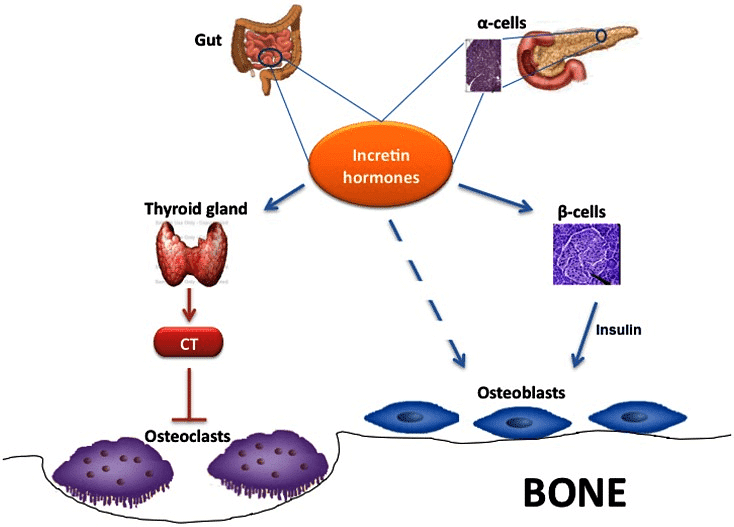
(b) Thyroid hormones: Thyroid hormones such as thyroxine, triiodothyronin, and thyrocalcitonin are secreted by the thyroid gland. Thyroxine maintains the basal metabolic rate of the body and regulates the carbohydrate, fat, and protein metabolism. Water and electrolyte balance is also maintained by thyroid hormones. Thyrocalcitonin or calcitonin lowers calcium level in blood plasma. It plays a significant role in calcium levels along with parathyroid hormone.
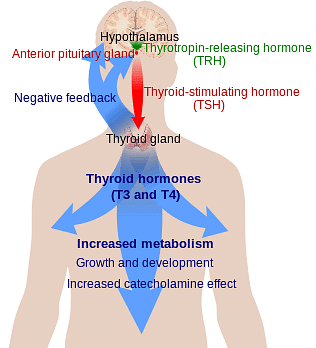 (c) Thymosins: Thymosin is secreted by the thymus gland. It plays a major role in protecting the body against infectious agents. It helps in the differentiation of T-lymphocytes and also promotes the reproduction of antibodies. Hence, it provides both cell-mediated and humoral immunity. Thymosins also help in the development of sex glands.
(c) Thymosins: Thymosin is secreted by the thymus gland. It plays a major role in protecting the body against infectious agents. It helps in the differentiation of T-lymphocytes and also promotes the reproduction of antibodies. Hence, it provides both cell-mediated and humoral immunity. Thymosins also help in the development of sex glands.
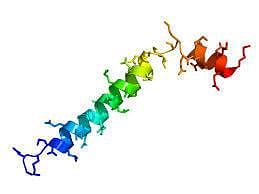 (d) Androgens: The leydig cells of testis produce androgens such as testosterone. Testosterone is a male sex hormone that regulates the development of secondary sex characteristics such as facial hair, hoarse voice, development of reproductive organ, etc. Androgens also regulate the development, maturation, and functions of various male accessory organs such as epididymis and prostate glands. It stimulates spermatogenesis and formation of mature sperms. It also influences male sexual behaviour.
(d) Androgens: The leydig cells of testis produce androgens such as testosterone. Testosterone is a male sex hormone that regulates the development of secondary sex characteristics such as facial hair, hoarse voice, development of reproductive organ, etc. Androgens also regulate the development, maturation, and functions of various male accessory organs such as epididymis and prostate glands. It stimulates spermatogenesis and formation of mature sperms. It also influences male sexual behaviour.
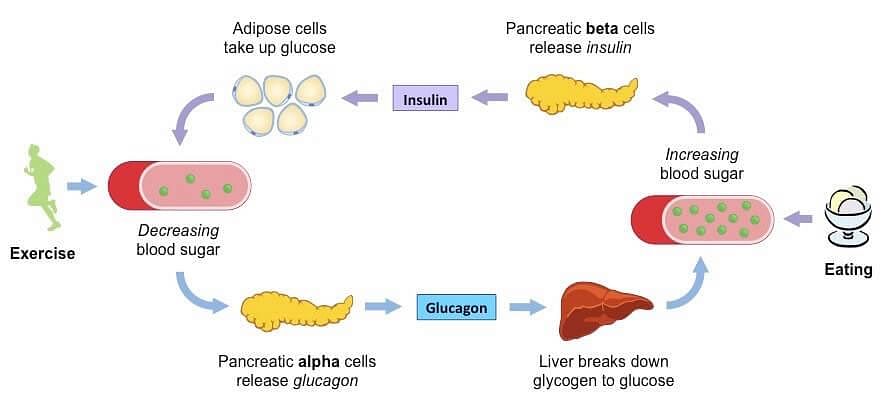
(e) Estrogens: Estrogen is the female sex hormone that controls the development of secondary sex characteristics such as enlargement of breasts and development of female reproductive organs. It plays a role in the development, growth and maturation of female secondary characteristics. It also helps in the development of growing ovarian follicles. It influences female sexual behaviour.
(f) Insulin and glucagon: Glucagon and insulin are secreted by cells of pancreas. They regulate the blood glucose level in the body. α-cells secrete glucagon that maintain a normal blood glucose level in the body, whereas β-cells secrete insulin that regulates the storage of glycogen in the liver.
Function of insulin: Insulin stimulates glycogenesis (conversion of glucose to glycogen). The rapid conversion of glucose from the blood to glycogen in hepatocytes and adipocytes results into a decreased glucose level. Insulin also prevents the formation of glucose from non-carbohydrate substances such as proteins and fats. Hence, it acts as a regulator of carbohydrate metabolism.
Function of glucagon: The main function of the glucagon is to increase the level of glucose when there is a deficiency of glucose in the body. This process is known as glycogenolysis.
Q6: Give example(s) of:
(a) Hyperglycemic hormone and hypoglycemic hormone
(b) Hypercalcemic hormone
(c) Gonadotrophic hormones
(d) Progestational hormone
(e) Blood pressure lowering hormone
(f) Androgens and estrogens
Ans: (a) Hyperglycemic hormone and hypoglycemic hormone: Hyperglycemic hormone is glucagon, while hypoglycemic hormone is insulin.
(b) Hypercalcemic hormone: Parathyroid hormone (PTH) is hypercalcemic hormone.
(c) Gonadotrophic hormones: Luteinizing hormone and follicle stimulating hormones are examples of gonadotrophic hormone.
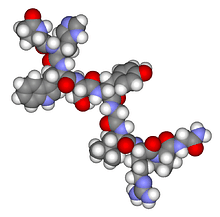
(d) Progestational hormone: Progesterone is a progestational hormone.
(e) Blood pressure lowering hormone: Atrial natriuretic peptide(ANP) is a blood pressure lowering hormone.
(f) Androgens and estrogens: Testosterone is an example of androgen, while an example of estrogen is estradiol.
Q7: Which hormone deficiency is responsible for the following?
(a) Diabetes mellitus
(b) Goitre
(c) Cretinism
Ans: (a) Diabetes mellitus is characterized by abnormally high glucose levels in the blood due to the deficiency of hormone, called insulin.
(b) Goitre is characterised by an abnormal enlargement of the thyroid gland due to the deficiency of thyroxin hormone in the body.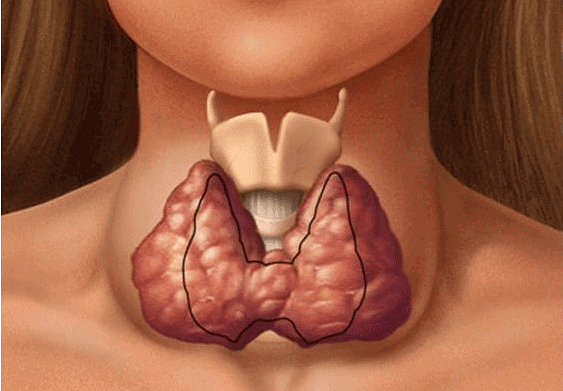
(c) Cretinism is characterized by stunted growth in the baby due to the deficiency of thyroid hormone in the body.
Q8: Briefly mention the mechanism of action of FSH.
Ans:
- Follicle stimulating hormone (FSH) is secreted by the pars distalis region of the anterior pituitary.
- It regulates the development, growth, and reproductive processes of the human body. In the ovary, FSH stimulates the growth and maturation of ovarian follicle. As the follicle grows and matures, it releases an inhibitory hormone known as inhibin that ends the process of FSH production.

- Action of FSH: Follicle stimulating hormone produces its effect by binding to its specific receptors present on the ovarian cell membrane.
- Binding of FSH hormone to its receptor leads to the formation of hormone receptor complex. The formation of this complex leads to biochemical changes in the ovarian follicle, present in the ovarian. The ovarian follicles mature and release a mature ovum in the fallopian tube for fertilization.
Q9: Match the following:
Ans:

|
182 videos|365 docs|153 tests
|
FAQs on NCERT Solutions Class 11 Biology Chapter 22 - Chemical Coordination and Integration
Ans. The endocrine system is a network of glands that secrete hormones into the bloodstream to regulate various bodily functions such as growth, metabolism, and reproduction. These hormones travel to target organs where they exert their effects, helping to maintain homeostasis in the body.
2. What are some common endocrine disorders that can affect chemical coordination and integration?$#
Ans. Some common endocrine disorders include diabetes, thyroid disorders, adrenal insufficiency, and growth hormone deficiency. These conditions can disrupt the normal functioning of the endocrine system, leading to various health problems.
3. How do hormones play a role in chemical coordination and integration?$#
Ans. Hormones are chemical messengers produced by the endocrine glands that regulate various physiological processes in the body. They help coordinate different organ systems and ensure they work together harmoniously to maintain internal balance and respond to external stimuli.
4. How does the hypothalamus-pituitary axis contribute to chemical coordination and integration?$#
Ans. The hypothalamus and pituitary gland are key components of the endocrine system that work together to regulate hormone production and secretion. The hypothalamus controls the pituitary gland's release of hormones, which in turn stimulate other endocrine glands to produce their hormones, thus coordinating the body's overall hormonal balance.
5. Can lifestyle factors such as diet and exercise impact chemical coordination and integration in the body?$#
Ans. Yes, lifestyle factors such as diet, exercise, stress, and sleep can influence hormone levels and overall endocrine function. Maintaining a healthy lifestyle with a balanced diet, regular physical activity, and adequate rest can help support optimal chemical coordination and integration in the body.

|
Explore Courses for NEET exam
|

|



















